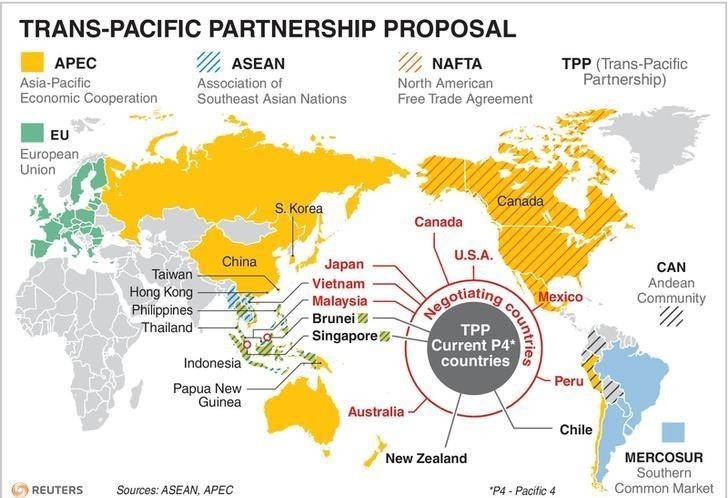Here’s what you need to know about the Trans-Pacific Partnership

The US pulled out of the TPP in 2017
Image: REUTERS/Marco Garcia
Stay up to date:
Trade and Investment
One of the first things President Donald Trump did when he took office was pull the United States out of the Trans-Pacific Partnership (TPP), a deal designed to strengthen economic ties between 12 countries that border the Pacific Ocean. It was a “horrible deal”, he said at the time.
Then, in April this year, it seemed he might backtrack. He tweeted that the US might rejoin, if the deal was "substantially better" than the one offered to President Barack Obama.
Accept our marketing cookies to access this content.
These cookies are currently disabled in your browser.
What is the TPP, and can it go ahead without the US?
Uniting the Pacific
The TPP is an ambitious free trade deal between the United States, Japan, Malaysia, Vietnam, Australia, Singapore, Brunei, New Zealand, Canada, Mexico, Peru and Chile.
Formal negotiations began while Barack Obama was President, with the deal characterized by the United States Trade Representative as an “agreement that will define the future rules of the road” for the Pacific region.
With the US included, the TPP would comprise around 40% of the world’s economic output. It would also constitute a trading bloc almost double the size of the European Union’s single market, and far larger than similar deals in the Pacific region, such as the North American Free Trade Agreement (NAFTA), which comprises the US, Canada and Mexico.
The US pulls out
Trump campaigned heavily against the TPP as part of his election campaign. The partnership faced fierce opposition from elsewhere, particularly activists and civil-society groups, as well as those who said it would give major corporations “extraordinary new powers” over workers and governments.
After the US pulled out, the 11 remaining nations pressed ahead, and the deal was renamed the Comprehensive and Progressive Agreement for Trans-Pacific Partnership (CPTPP). The CPTPP covers a market of 500 million people.
How fair is the CPTPP?
Trump’s assertion that the deal is unfair might be valid. A report by the Peterson Institute for International Economics (PIIE) says that some nations are indeed getting a better deal than others.
For example, by 2030, Brunei, Singapore and Vietnam will each get an economic boost of at least 2%, while Malaysia’s economy is expected to grow by over 3%. In contrast, the boost to the US economy would only be around 0.5%.
For consumers, the price of many goods and services is expected to drop within CPTPP countries. The New Zealand Foreign Affairs and Trade Department estimates that tariffs on New Zealand beef exports to Japan will be cut from 38.5% to just 9%, for example.
And tariffs on some products will disappear entirely. Trainers exported to Mexico would eventually become tariff-free, while tariffs on shampoo exported to Vietnam will be cut from 15% to 0%.
The CPTPP is expected to be ratified early next year, which is the earliest the United States could formally start negotiations to join.
While the addition of the US could strengthen it, its involvement now rests on the 11 CPTPP member states agreeing to admit a new member.
Don't miss any update on this topic
Create a free account and access your personalized content collection with our latest publications and analyses.
License and Republishing
World Economic Forum articles may be republished in accordance with the Creative Commons Attribution-NonCommercial-NoDerivatives 4.0 International Public License, and in accordance with our Terms of Use.
The views expressed in this article are those of the author alone and not the World Economic Forum.
Forum Stories newsletter
Bringing you weekly curated insights and analysis on the global issues that matter.
More on Trade and InvestmentSee all
Yusuf Maitama Tuggar
July 10, 2025
Bright Simons
July 7, 2025
Erik Crouch
July 1, 2025
Spencer Feingold and Kimberley Botwright
June 25, 2025
John Letzing
June 25, 2025






